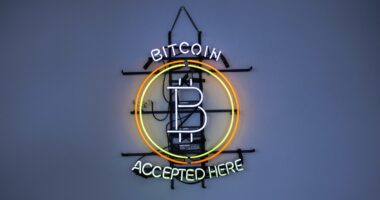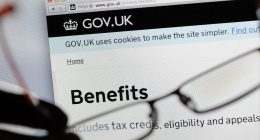
Uncomfortably high inflation will grip the U.S. economy well into 2022, as constrained supply chains keep upward pressure on prices and, increasingly, curb output, according to economists surveyed this month by The Wall Street Journal.
The economists’ inflation projections are up dramatically from July, while short-term growth outlooks are lower.
Economists on average see inflation at 5.25% in December, just slightly less than the rate that has prevailed since June. Assuming a similar level in October and November, that would mark the longest inflation has been above 5% since early 1991.
“It’s a perfect storm: supply-chain bottlenecks, tight labor markets, ultra-easy monetary and fiscal policies,” said Michael Moran, chief economist at Daiwa Capital Markets America.
Consumer-price inflation will drop to 3.4% by June of next year, then 2.6% by the end of 2022, according to respondents’ average estimates. That is still above the average 1.8% that prevailed in the decade before the pandemic.
Economists slashed growth forecasts this year, to an average 3.1% annualized in the third quarter from 7% in the July survey. They also lowered projected fourth-quarter growth to 4.8% from 5.4%.
“Consumer spending, and by extension GDP growth, is being limited by high rates of inflation eroding the real purchasing power of consumers,” said Michael Brown, principal U.S. economist at Visa.
Concerns about limited supply are the main cloud over the outlook. Around half of respondents cited supply-chain bottlenecks as the biggest threat to growth in the next 12 to 18 months, while nearly one-fifth pointed to labor shortages. They also expect supply-chain woes to weigh on the economy through much of next year. Some 45% estimate that it will take until the second half of 2022 for bottlenecks to have mostly receded, compared with two-fifths expecting major improvement before then.
Concerns about Covid-19 have receded. It was flagged by just 8.2% of respondents as the main risk to growth. Still, some respondents said that Covid-19 is the biggest factor in setting the economy’s course for the next year or so. “Fundamentally, it’s Covid and people’s reaction to it that’s leading to labor shortages and supply-chain bottlenecks, which in turn is feeding into higher inflation,” said Leo Feler, senior economist at UCLA Anderson Forecast.
Many economists cited unusually robust demand for goods throughout the pandemic as the chief source of strained supplies—and, as a result, a key source of inflationary pressure. Goods demand has remained high even as widespread vaccination allowed the economy to reopen and for consumers to resume spending on services. When supply-chain-induced pressure on prices subsides depends to some extent on when consumers rebalance their spending, said Constance Hunter, chief economist at KPMG.
“The question right now is, are they going to spend on goods or services?” she said. “Is the box under the Christmas tree going to be another piece of exercise equipment, or like, ‘Hey, we’re going on vacation in March?’ ”
If the economists’ projections are borne out, the Federal Reserve might have to raise interest rates to keep inflation under control, slowing the economy and upping the risk of a downturn. Nearly three in five economists surveyed see the Fed raising rates by the end of next year, including 16% who see the first increase happening by the Fed’s June meeting.
Elevated inflation for several years could ripple through the economy in various ways. Consumers could find their household budgets squeezed. Increased borrowing costs could weigh on stock values and stymie interest-sensitive industries like housing.
However, while the survey projects higher inflation and less growth this year than what occurred a few months ago, it also shows optimism about the next couple of years. Respondents boosted growth forecasts slightly, to 3.6% in 2022 and 2.5% in 2023, based on the change in inflation-adjusted gross domestic product in the fourth quarter from a year earlier.
KPMG’s Ms. Hunter said, “2022 is going to be a perplexing year in many regards.” Growth will be very strong, around 4%, “but it is going to be [hard] for businesses and consumers to manage through this period of higher prices—it’s unpleasant and challenging.”
In minutes of the Federal Reserve’s policy meeting last month, released this past week, some officials said rates might need to rise from near zero by the end of next year because they expected the labor market and inflation to meet their goals. Another group was more optimistic that inflation would come down on its own to the Fed’s 2% target and worried raising rates prematurely could undermine the Fed’s recent commitments to keeping inflation from later drifting below 2%.
“This is a high-wire act for the Fed, and it’s hard for [Fed Chairman Jerome] Powell to not sound tone-deaf on inflation given the pain consumers are facing at the grocery stores and at the gas pump,” said Diane Swonk, chief economist at Grant Thornton. “Rent is going to be accelerating even as some of the supply-chain disruptions ease. And that’s going to make it very difficult for the Fed to determine by mid-2022 if the inflation is episodic and/or has become more entrenched.”
The Wall Street Journal survey of 67 business, academic and financial forecasters was conducted Oct. 8-12. Not all participants responded to every question. The survey archives and forecast data can be found here.
Write to Gwynn Guilford at [email protected] and Anthony DeBarros at [email protected]
Copyright ©2021 Dow Jones & Company, Inc. All Rights Reserved. 87990cbe856818d5eddac44c7b1cdeb8








